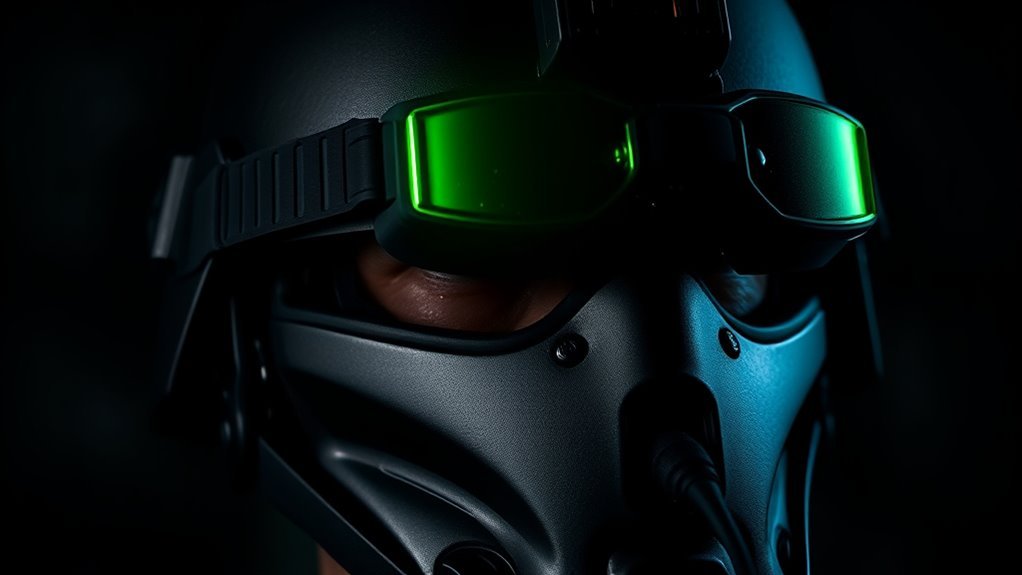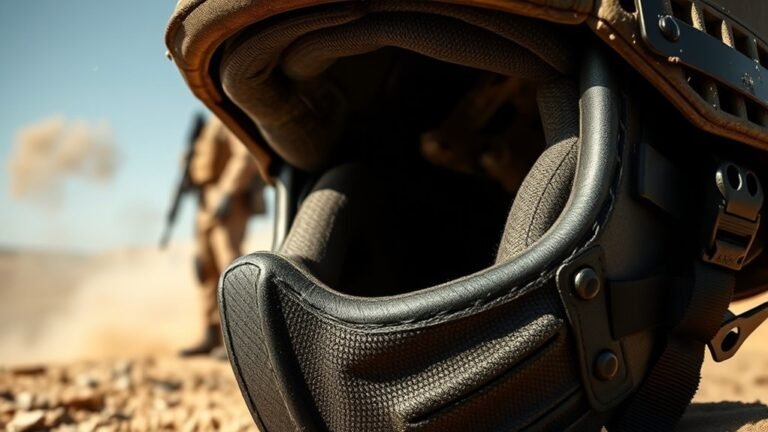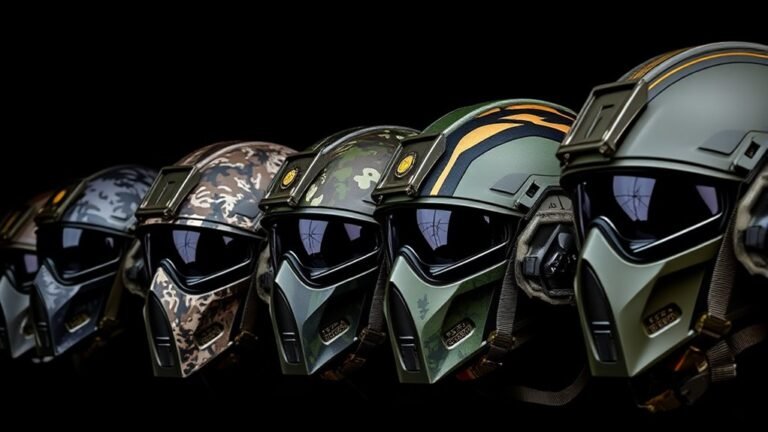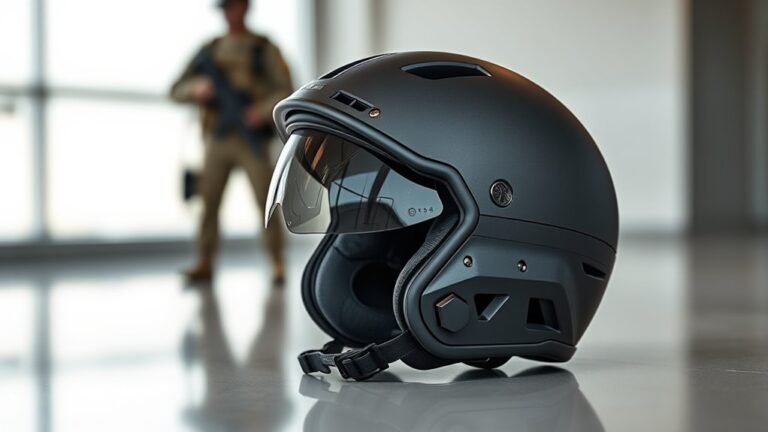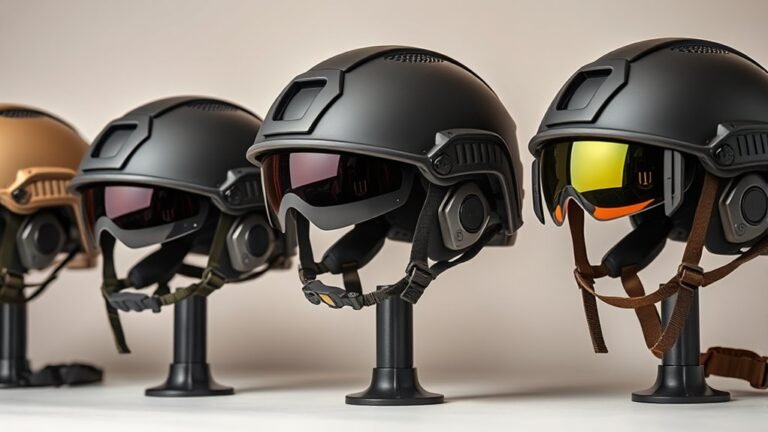Night Vision Compatibility in Military Helmets
Night vision compatibility in military helmets is essential for enhancing your operational effectiveness during low-light conditions. Such helmets feature integrated mounting systems for thermal imaging and image intensification devices, ensuring you can identify threats effectively. Lightweight designs improve comfort on extended missions, while built-in communication systems maintain team coordination. The fusion of advanced night vision technology with helmet design boosts situational awareness and increases mission success rates. Discover more about the innovative features that can elevate your performance on the battlefield.
The Importance of Night Vision in Modern Warfare
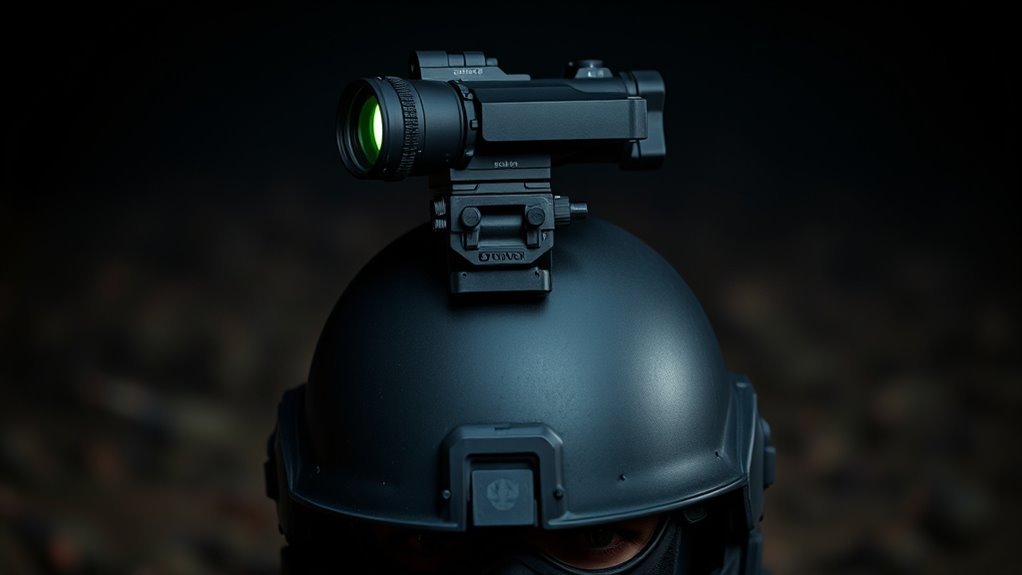
As modern warfare increasingly takes place under the cover of darkness, the ability to see clearly at night has become a critical advantage for military operations. Night vision technology provides tactical advantages that enhance soldiers’ situational awareness, enabling them to identify threats and navigate challenging terrain effectively. This capability greatly boosts operational effectiveness, allowing forces to conduct missions with precision and reduced risk of detection. By leveraging night vision, you can outmaneuver adversaries, exploit vulnerabilities, and maintain initiative in low-light conditions. The integration of night vision systems into your toolkit is not just an enhancement; it’s a necessity for ensuring mission success and safeguarding freedom. In an era where every moment counts, this advantage is invaluable for achieving strategic objectives.
Key Features of Night Vision-Compatible Helmets
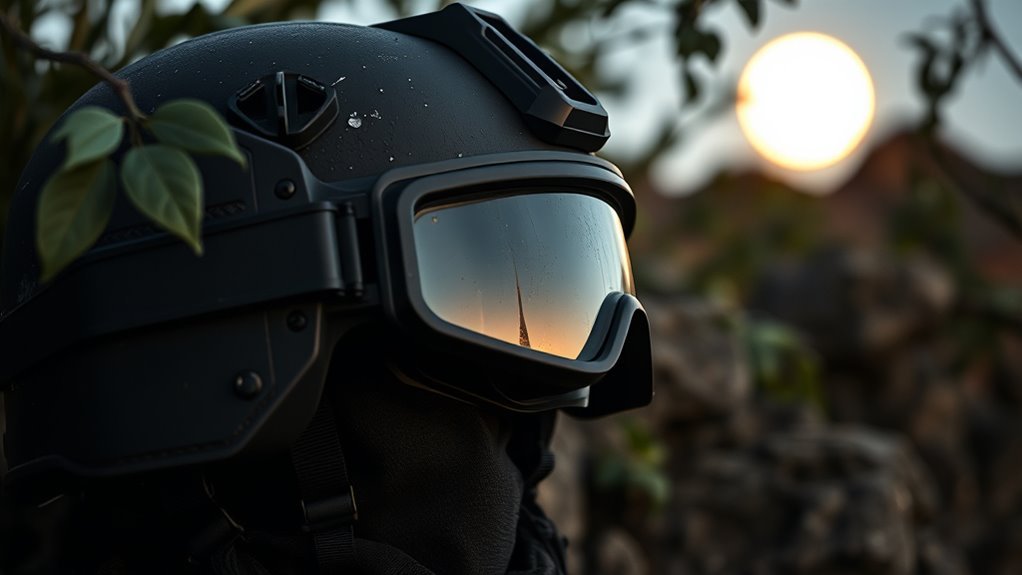
Night vision-compatible helmets are engineered to optimize the use of advanced night vision equipment, making them integral to modern military operations. These helmets feature integrated mounting systems for thermal imaging devices, allowing you to attach and adjust your gear seamlessly. Lightweight materials guarantee comfort during extended missions, while high-visibility surfaces enhance safety in low-light conditions. The adjustable fit and padding provide stability and minimize movement, essential when using helmet accessories like night vision goggles. Additionally, many models include built-in communication systems, enabling clear coordination with your team. With these features, you’ll gain a tactical advantage in darkness, guaranteeing operational effectiveness and freedom to maneuver without compromising safety or performance. Embrace the technology that keeps you ahead in the field.
Design Considerations for Enhanced Night Vision
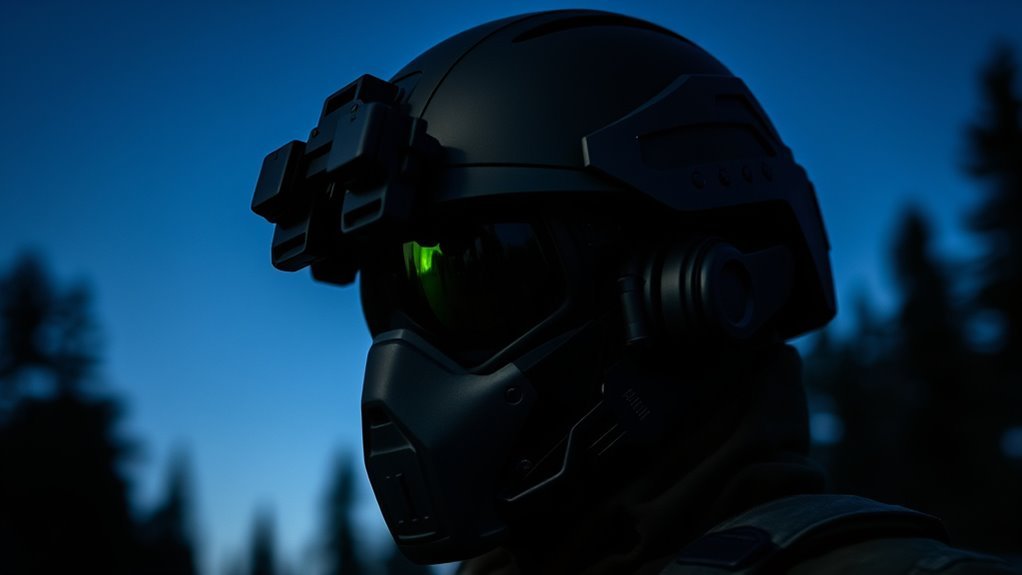
When designing helmets for enhanced night vision, you’ll need to take into account optics alignment techniques to guarantee peak performance. Weight distribution strategies are essential for maintaining comfort and stability during prolonged use. Additionally, ambient light adaptation features can greatly improve visibility in varying conditions, enhancing overall mission effectiveness.
Optics Alignment Techniques
Achieving ideal optics alignment in military helmets is essential for maximizing night vision effectiveness. Proper optics calibration guarantees that your equipment functions at its best, allowing you to maintain situational awareness in low-light environments. Use precise alignment techniques to position the night vision device accurately relative to your line of sight. This minimizes distortion and enhances target acquisition.
Regular calibrations should be conducted to counteract any shifts that may occur during use or equipment adjustments. Incorporating adjustable mounts can further refine alignment, allowing for quick adaptations in different operational scenarios. By prioritizing these techniques, you empower yourself with reliable night vision capabilities, guaranteeing you’re always prepared for any mission, regardless of the darkness that lies ahead.
Weight Distribution Strategies
Proper weight distribution in military helmets is essential for enhancing night vision performance, as it directly affects user comfort and stability during operations. Implementing effective load balancing strategies guarantees that the weight is evenly distributed across your head, minimizing strain and fatigue. You’ll want to take into account comfort adjustments such as adjustable straps and padding that can conform to your unique head shape, allowing for a secure fit. This not only enhances stability but also keeps your night vision equipment properly aligned. By focusing on these aspects, you can maintain operational effectiveness in low-light conditions while enjoying greater freedom of movement. Ultimately, a well-designed helmet with optimized weight distribution empowers you to perform at your best.
Ambient Light Adaptation
Weight distribution strategies greatly impact comfort and stability, but to maximize night vision capabilities, understanding ambient light adaptation is key. The human eye’s ability to adjust to varying ambient light levels can markedly enhance visual acuity in low-light conditions. Military helmets must incorporate features that facilitate this adaptation, such as anti-reflective coatings and refined visor designs. These elements reduce glare from ambient light, thereby improving clarity and depth perception. Additionally, the integration of flexible lighting systems can help mitigate sudden changes in light intensity, allowing for smoother shifts. By focusing on these design considerations, you can guarantee that soldiers maintain peak visual performance while maneuvering complex environments, ultimately preserving their freedom to operate effectively in diverse conditions.
Types of Night Vision Technologies Used
As military operations increasingly rely on advanced technology, understanding the various types of night vision systems becomes essential for effective field deployment. Two primary categories dominate: thermal imaging and image intensification.
Thermal imaging detects infrared radiation, allowing you to see heat signatures, which is vital for identifying targets in complete darkness or through obscurants like smoke. In contrast, image intensification amplifies available light, such as starlight or moonlight, enhancing visibility in low-light conditions.
Both technologies serve distinct roles on the battlefield. By integrating these systems into your helmet gear, you can maximize situational awareness and operational efficiency. Knowing the strengths and limitations of each type helps you make informed decisions, ensuring you’re equipped for a variety of nighttime scenarios.
Integration of Night Vision Systems in Helmets
Integrating night vision systems into military helmets enhances operational capabilities considerably. This integration allows you to engage in low-light situations while maintaining situational awareness. Key components of this integration include:
- Helmet Mounted Displays: These provide real-time imagery, guaranteeing you can navigate and identify targets effectively.
- Tactical Communication Integration: Seamless connectivity with communication systems enhances coordination with team members, allowing for informed decision-making.
- Weight Distribution and Comfort: Proper design guarantees that the additional equipment doesn’t compromise your mobility or comfort during extended missions.
With these advancements, you’re equipped to operate more efficiently, guaranteeing that freedom remains a priority in every engagement. The evolution of military helmets is vital for maintaining tactical advantages in modern warfare.
Future Trends in Military Helmet Technology
As military helmet technology evolves, you’ll notice enhanced night vision integration becoming standard, improving operational effectiveness in low-light conditions. The shift toward lightweight materials will not only increase comfort but also reduce fatigue during extended missions. Additionally, smart helmet features are set to revolutionize situational awareness, providing real-time data directly to the user.
Enhanced Night Vision Integration
While advancements in night vision technology continue to evolve, military helmets are increasingly designed to seamlessly integrate these enhancements for improved operational effectiveness. Enhanced night vision integration means you can expect:
- Thermal imaging compatibility – allowing you to detect heat signatures in low-light environments.
- Versatile helmet accessories – enabling attachments like advanced optics, which enhance situational awareness and target acquisition.
- Integrated power sources – ensuring your night vision devices function continuously without interruption.
These innovations provide soldiers with a tactical advantage, empowering them to operate effectively under the cover of darkness. The fusion of technology and design in military helmets not only enhances visibility but also reinforces your ability to maintain freedom in complex operational scenarios. This is the future of combat readiness.
Lightweight Materials Development
The integration of enhanced night vision technologies has set the stage for further innovations in military helmet design, particularly in the development of lightweight materials. You’ll find that modern helmets increasingly utilize lightweight composites and advanced polymers to reduce overall weight without sacrificing protection. These materials not only improve comfort during extended missions but also enhance maneuverability, allowing for greater freedom of movement in critical situations. Research is focused on optimizing these composites for durability, ensuring they withstand extreme environments while maintaining a low profile. As manufacturers adopt cutting-edge techniques, you can expect future helmets to feature even lighter, more resilient materials that can seamlessly integrate with night vision systems, providing soldiers with the performance edge they need in the field.
Smart Helmet Features
With advancements in technology reshaping military operations, smart helmet features are poised to revolutionize soldier safety and effectiveness on the battlefield. These helmets integrate cutting-edge augmented reality, enhancing situational awareness. Here are three key features you can expect:
- Heads-Up Display: Real-time data on enemy positions, mission objectives, and environmental conditions, all visible without diverting your gaze.
- Integrated Communication Systems: Secure, real-time voice and data communication, allowing seamless coordination with your team while minimizing distractions.
- Health Monitoring Sensors: Essential sign tracking, providing immediate feedback on your physiological condition to prevent potential health crises during demanding operations.
These innovations in smart helmet technology guarantee you stay connected and informed, ultimately empowering you to operate with greater freedom and efficiency.
Frequently Asked Questions
What Are the Weight Implications of Night Vision-Compatible Helmets?
When considering night vision-compatible helmets, weight implications are significant. Proper weight distribution is vital to maintain balance and prevent fatigue during extended wear. Lighter helmet materials, like advanced composites, can reduce overall weight without sacrificing protection. However, integrating night vision systems can add bulk, so it’s important to optimize design for both functionality and comfort. Balancing weight and performance guarantees you remain agile and effective in critical situations, enhancing your operational freedom.
How Do Weather Conditions Affect Night Vision Performance?
Weather conditions can dramatically influence night vision performance, almost like turning the lights off at a party! Rain, fog, or snow can severely reduce visibility range, making it tough to spot targets. Humidity and temperature shifts can also affect the clarity of your optics. When the weather’s not cooperating, your night vision capabilities can feel like they’ve been thrown into a dark abyss, limiting your operational effectiveness and freedom of movement.
Are Night Vision Helmets Compatible With Communication Devices?
Yes, night vision helmets can be compatible with communication devices. When selecting a helmet, make certain it has proper communication integration features, allowing seamless connectivity with various devices. Many modern helmets come equipped with built-in systems or mounts for headsets, enhancing operational efficiency. Always check device compatibility specifications to assure peak performance during missions. This integration not only improves situational awareness but also supports your freedom of movement and communication in the field.
What Maintenance Is Required for Night Vision Systems?
To maintain your night vision systems, follow specific cleaning procedures and battery care guidelines. Regularly clean the lenses with a microfiber cloth to avoid scratches. Inspect and replace batteries as needed, making certain they’re stored correctly to prevent leakage. Keep the housing free from dirt and debris to guarantee peak performance. By adhering to these maintenance practices, you’ll prolong the lifespan and functionality of your night vision equipment, enhancing your operational effectiveness.
Can Night Vision Helmets Be Used for Civilian Purposes?
Sure, you can use night vision helmets for civilian purposes—if you enjoy maneuvering through legal regulations! While they’re designed for military applications, they can be adapted for activities like hunting or surveillance. Just remember, you’ll need to check local laws to guarantee compliance. It’s ironic how the tech meant to provide safety can be tangled in red tape, but with the right knowledge, you can enjoy those civilian applications effectively and responsibly.
